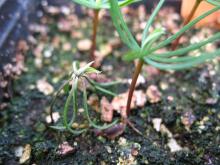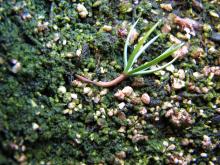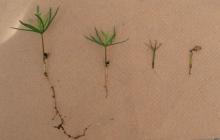See:
Fir, Douglas and True - Hypocotyl Rot and Root Rot
Spruce (Picea spp.) - Cylindrocarpon Root Rot
Cause Several soilborne fungi including Fusarium, Pythium and Rhizoctonia species have been reported to cause damping-off. Fusarium and Pythium species are the most common. In most container and bareroot nurseries, Fusarium is ubiquitous in nursery soils, on seeds of several conifer species, and on healthy and diseased conifer seedlings, especially Douglas-fir, western white pine (Pinus monticola), and ponderosa pine. Fusarium commune, however, is the primary species of Fusarium associated with root disease in conifers.
Approximately 20 species of Pythium have been found in forest nursery soils and eight species, including P. dissotocum, P. irregulare, P. mamillatum, P. sylvaticum, and P. ultimum, are aggressive pathogens of tree seedlings causeing extensive Douglas-fir seedling mortality.
Diseases caused by Fusarium and Pythium are generally more serious in bareroot nurseries than in greenhouse container nurseries, where contamination of growing media, temperature, and irrigation are controlled more easily. However, these fungi can become a problem if growing media become contaminated or a pathogen is introduced on seeds or in irrigation water. These fungi are able to survive for various periods as resting spores or as mycelium in soil and residual host tissues, and they can be seedborne. They also can persist in styroblocks and other containers.
Seedlings are infected when favorable soil moisture and temperature conditions and seed or root exudates are present. Pythium produces a motile spore (zoospore), which can readily spread in water film to infect roots. Infection typically occurs early in the growing season when soils are still moist and cool and seedling tissues are young. Fusarium species may be seedborne and can cause pre- and post-emergence damping-off as well as hypocotyl rot and root rot later in the growing season. Cool soil and improper planting depth, with slow germination and emergence rates, favor disease development.
The practice of tilling in "green manure" cover crops can aggravate disease problems by providing high levels of organic matter that result in increased pathogen levels. A bare fallow rotation instead of cover crop can significantly reduce pathogens and improve fumigation efficacy.
Symptoms Seedlings' fail to emerge from soil or rapidly wilt shortly after emergence. Seeds may rot before they germinate (preemergence damping-off).
Cultural control
- Avoid poorly drained soil.
- Use seeds that are properly conditioned.
- Rotate planting beds with nonsusceptible hosts such as small grains to reduce fungal inoculum levels. Avoid legume cover crops. Keeping beds weed free and fallow with periodic tilling during inter-rotational seasons is even better.
- Designate separate isolation beds for growing nursery stock that arrives from other nurseries.
- Do not reuse planting containers, or thoroughly wash and disinfect them if they are reused. Sanitizing styroblocks by heat, fungicide, or biocide treatment can help control disease problems. Discard older styroblocks because after multiple uses sanitation efficacy is reduced.
- Use well water or filter and/or decontaminate surface water used for irrigation. Irrigate only enough to thoroughly wet the root zone. Water as needed based on water use of the seedlings.
- Plant when soil temperature is warm enough to promote rapid germination and emergence.
- Soil pH between 5.2 and 5.7 is ideal for most Pacific Northwest conifers.
- Clean equipment before being shared or exchanged between nurseries.
Chemical control
- Preplant fumigation is the most commonly used control in conifer nurseries, but cultural practices can reduce the need to fumigate.
- Basamid; see label. 5-day reentry. Restricted-use pesticide, Washington only.
- Telone II. Rates are based on planting depth and soil type. See label for details. 5-day reentry. Restricted-use pesticide.
- Telone C-17. Rates are based on planting depth and soil type. See label for details. 5-day reentry. Restricted-use pesticide.
- Seed treatment is not recommended, as it has not been very successful.
- Postplant fungicides for Pythium. Rotate fungicides from different groups that have a different mode of action for resistance management.
- Adorn at 1 to 4 fl oz/100 gal water plus another fungicide is registered for Grand and Noble Fir grown in many different situations including as Christmas trees or ornamentals grown indoors or outdoor landscapes. Group 43 fungicide. 12-hr reentry.
- Aliette at 1.25 to 4 lb/100 gal water for conifers in nurseries. Do not use with adjuvants. Group P7 fungicide. 24-hr reentry.
- Areca at 2.5 to 5 lb/100 gal water as a foliar application for conifers in nurseries. Group P7 fungicide. 12-hr reentry.
- Banrot 40 WP at 6 to 12 oz/100 gal water. For use in commercial greenhouses. Group 1 + 14 fungicide. 12-hr reentry.
- Fosphite at 1 to 2 quarts/100 gal water. Do not use copper products within 20 days of treatment and do not use spray adjuvants. Registered for conifers in commercial nurseries, plantations, forests, landscapes, and parks including Christmas trees. Group P7 fungicide. 4-hr reentry.
- Mefenoxam 2 AQ at 1.23 pints/A as a broadcast spray over beds in at least 50 gal water at seeding or transplanting. Use at 2.45 pints/A as a broadcast spray for newly transplanted 2-year-old seedlings. Do not use as a curative treatment. Registered for conifers in nurseries and plantations including Christmas trees. Group 4 fungicide. 48-hr reentry.
- Rampart at 1 to 2 quarts/100 gal water/A. Registered for conifers in commercial nurseries, plantations, forests, landscapes, and parks including Christmas trees. Group P7 fungicide. 4-hr reentry.
- Subdue MAXX at 1.25 pints/A as a broadcast spray over beds in at least 50 gal water at seeding or transplanting. Use at 2.5 pints/A as a broadcast spray for newly transplanted 2-year-old seedlings. Do not use as a curative treatment. Registered for conifers in nurseries and plantations including Christmas trees. Group 4 fungicide. 48-hr reentry. No restrictions on reentry when used as a soil drench.
- Terrazole 35 WP at 3.5 to 10 oz/100 gal water as a soil drench only at time of seeding or transplanting. For use in commercial nurseries and greenhouses. Group 14 fungicide. 12-hr reentry.
- Postplant fungicide drench for Fusarium. Variable efficacy from trial to trial.
- Cleary's 3336 EG at 8 to 16 oz/100 gal water. Registered for use in nurseries, greenhouse, shade or lath house, and landscapes. Group 1 fungicide. 12-hr reentry.
- Tourney EZ at 1 to 4 oz/100 gal water in a volume of 1 to 2 pts of solution per square foot of surface area. Group 3 fungicide. 12-hr reentry.
Biological control Several biocontrol formulations have been tested for efficacy in preventing or treating damping-off and root diseases in conifer nurseries, but so far few have proven effective.
RootShield Plus Granules (Trichoderma harzianum Rifai strain T-22 and T. virens strain G-41) at 1 to 3 lb/cubic yard of soil mix. No restrictions on reentry when soil incorporated.
References Stewart, J.E., Kim, M.S., James, R.L., Dumroese, R.K., and Klopfenstein, N. B. 2006. Molecular characterization of Fusarium oxysporum and Fusarium commune isolates from a conifer nursery. Phytopathology 96:1124-1133.
Stone, J.K., Hildebrand, D.M., James, R.L., and Frankel, S.J. 1997. Alternatives to chemical fumigation in bareroot forest nurseries: Effects on pathogen levels and seedling density, mortality and quality. In: James, R.L. (ed.) Proceedings of the third meeting of the IUFRO working party S7.03-04 diseases and insects in forest nurseries. USDA Forest Service Report 97-4. USDA Forest Service Northern Region, Couer d'Alene, ID.
Weiland, J., Garrido, P., Kamvar, Z.N., Espindola, A.S., Marek, S., Grünwald, N.J., and Garzón, C. D. 2015. Population structure of Pythium irregulare, P. ultimum, and P. sylvaticum in forest nursery soils of Oregon and Washington. Phytopathology 105:684-694.




